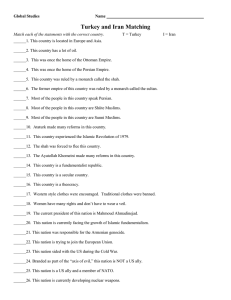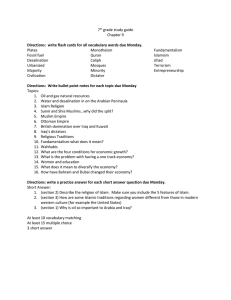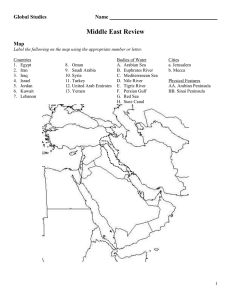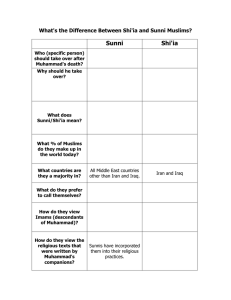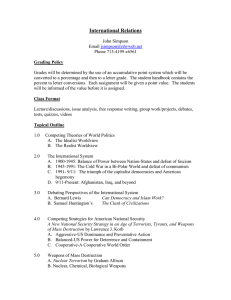Southwest Asia Chapters 19-20 The Persian Gulf and Interior The Eastern Mediterranean
advertisement
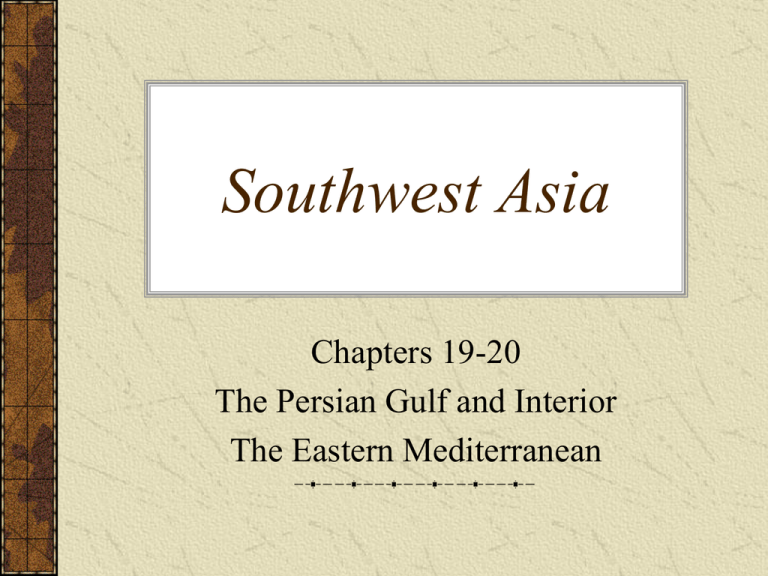
Southwest Asia Chapters 19-20 The Persian Gulf and Interior The Eastern Mediterranean The Persian Gulf and Interior The Arabian Peninsula is between the Red Sea and the Persian Gulf and includes the following countries: Saudi Arabia The United Arab Qatar Emirates Bahrain Kuwait Oman Yemen Red Sea (Saudi-Arabia in distance) Iraq and Iran are also on the Persian Gulf. Landlocked Afghanistan lies to the northeast of Iran. Tectonic activity that causes earthquakes Mesopotamia – Greek for “between rivers” – Lies mostly in Iraq between the Tigris and Euphrates rivers – Very fertile for crops by the rivers – Exotic rivers are in humid regions and then flow across dry areas. Hot and dry climates dominate this region Mesopotamia Khezr Beach, Hormoz Island, Persian Gulf, Iran 900 private A Has 304-room Armani Tallest building residential Burj Khalifa, Hotel, theapartments first of four in the world (which, according to the Dubai, United by Armani, occupies 2,722 ft out within developer, sold Arab Emirate 15 of the lower 39 eight hours of being on floors the market) Kingdom Centre, Riyadh, Saudi Arabia The second floor of Kingdom Centre is dedicated to a Ladies' Kingdom, a private shopping mall for women that's said to have "almost everything a female would need" -- including a ladies' bank and ladies' mosque. Bahrain world'sWorld first windTrade Center, powered, Manama, megastructure Bahrain (13%) produce about 25%hold of the world's oil nearly two-thirds of the world's crude oil reserves 35% of the world natural gas reserves Bahrain History and Culture Fertile Crescent – Area of fertile soil – World’s first civilizations developed here – Many of the plants and animals found in the world today were first domesticated here. 3000 B.C. the Sumerians built the world’s first known cities in southern Mesopotamia. Rich resources of Mesopotamia have always attracted invaders and the land has changed hands from many empires and kingdoms. Sumerian writing Sumerian Ruins – City of Ur Model Reconstruction – City of Ur Islam – Mohammad • Founder who was born in Mecca, Saudi Arabia • Lived in this area from about 570 to 632 A.D. • Age 40 he reported that the angel Gabriel, sent from Allah, had told him to preach Allah’s word. • Followers became known as Muslims and his writing were collected into the Qur’an (Koran) • Established a Muslim community center at Medina • After death, Arab armies spread Islam to Morocco and Spain. Mecca – holiest city for this religion; Muslims are required to make a pilgrimage to Mecca at least once. One of the world’s most practiced religions Holy centers are called mosques Mohammad never Mohammad introduced a was descended new God but from Abraham instead spoke of through his son the God of Ishmael Abraham, Jesus, and Moses Mecca Mecca The Great Mosque Medina Qur’an (Koran) Mongols – 1200’s – Conquered what are now Afghanistan, Iran and Iraq Mongol Ruler – Genghis Khan Cultural diffusion Safavids – Rulers who came into power in Iran in early 1500s – Caused a golden age in Persian culture, literature, and architecture – Dynasty ended in the mid 1700’s Ottoman Turks – 1500’s conquered much Mesopotamia and the east and west coast of the Arabian Peninsula – Early 1900’s, lost control when the British took it over Ottoman Turk Empire Iraq and Saudi Arabia emerged as independent countries in 1932. Kuwait, Bahrain, Qatar, the United Arab Emirates, and Yemen became independent from Britain in the 1960’s and 1970’s. Islam is the identifying culture of this region. Arabic is the dominant language. قفز الثعلب البني السريع فوق الكلب الكسول There are over a million Arabs in southern Iran, but there are also many non-Arabic ethnic groups. – Kurds • Are Muslim but not Arabic • Live in the borderlands of Iran, Iraq, Syria and Turkey • Desire for self rule is a source of political tension throughout the region Arab Kurds Most of Iran’s people are Persians who speak Farsi and they dominate the important positions in the country. The other ethnic groups have little say in what goes on. In Afghanistan the Pashtun make up the largest ethnic group (they are actually a number of tribes that speak the Pashtu language.) Sunni and Shia Islam has split into two main branches: Sunni and Shi’ism. The difference centers on their choice of leader or imam. The Sunni Muslims choose their imams. The Shia Muslims believe that only a descendant from Mohammad can be an imam. The Shia also rely on imam to interpret the Qur’an and the Sunni use them mainly as prayer leaders. About 90% of Muslims are Sunni and 10% are Shia. Shi’ism is concentrated in Iran, southern Iraq, Yemen, Syria and Lebanon. The Region Today The regions politics center around three themes: oil, tradition, Islam Islam prevent eating pork; no pigs are raised in these areas. Oil and gas production – Central to the countries along the Persian Gulf – The Organization of Petroleum Exporting Countries (OPEC) influences oil prices throughout the world by increasing or decreasing production to regulate prices. – Saudi Arabia • 8.25 million barrels of oil a day • Key member of OPEC. • World’s largest oil exporter • Special place in world affairs because other places need more oil than what they can produce The Organization of Petroleum Exporting Countries (OPEC) Super tankers off the coast of Kuwait Saudi Oil Production Persian Gulf must import food. Nomadic herders known as Bedouins live in the outlying dry lands. Beduoins Iran Unstable politics In 1979 there was a revolution that toppled Iran’s monarchy. The government became a theocracy (religion based government) ran by ayatollahs (religious leaders of high authority among Shia Muslims.) Many leaders view western ideas as a threat. Many Iranians are seeking more personal freedoms. Global concern – If they close off the Strait of Hormez, it could cut off a large portion of the world’s oil supply. Mohammad Reza Shah Pahlavi Ayatollah Ruhollah Khomeini Iraq Until 2003, Iraq was ruled by Dictator Saddam Hussein who used the country’s oil reserve to build a large military. Under Saddam, Iraq invaded Iran in 1980 and Kuwait in 1990. A group of countries led by the US repelled the Iraq invasion of Kuwait in 1991 to keep stability in the region. This became known as the Persian Gulf War. Iraq Saddam Hussein Ruled 1979 – 2003 Captured in 2003 Executed in 2006 for having 148 Iraqi Shi’ites killed in 1982 San Francisco 1991 To prevent this from happening again the United Nations ordered Saddam to stop producing weapons of mass destruction. In 2003, after Iraq’s continued resistance to UN inspectors and violations of UN sanctions the United States led an invasion of the country. Iraq forces were defeated and Hussein was captured and executed. Instability in the region has led to the rise of militant groups like ISIS (Islamic State in Iraq and Syria) Afghanistan Afghanistan’s ethnic and political conflicts have long plagued the country. In the 1990’s Taliban came into power. Extreme version of Sunni Islam Established strict laws for the country based on Sharia Law. After the Sept. 11th terrorist attacks, US officials focused on the aid the terrorists received from the Taliban government. The US and allied forces attacked terrorist camps and Taliban military targets. The Taliban regime soon collapsed. Freed from the Taliban, Afghanistan experienced new liberties though instability still hurts the country. Afghanistan Eastern Mediterranean Countries Eastern Mediterranean is part of the Middle East and has six countries: Israel Jordan Lebanon Syria Turkey Cyprus Eastern Mediterranean Turkey – Lies in both Europe and Asia – Has many faults and experiences devastating earthquakes. Israel, Lebanon and Syria lie in the coastal plain region Dead Sea – The Jordan River flows into it – 1,312 feet below sea level – Once part of the Mediterranean Sea, but it no longer has an outlet – It is so salty nothing can live in it and anyone can easily float in it. Jordan River Dead Sea Dead Sea Arid, Semiarid and Mediterranean climates cover this region. Lebanon used to be famous for its many cedar trees but most have been deforested over the last 2,000 years. In about 1,000 BC the Hebrew people set up a kingdom between the Jordan River and the Mediterranean Sea. Hebrews practice Judaism, which is dominant in Israel. Judaism The Romans conquered the Eastern Mediterranean between 200BC and AD 106. Roman Empire Jesus was born at the beginning of the first century in Bethlehem, Israel. His ministry throughout the Jerusalem area changed this region. In the first century AD, Christianity began to spread throughout this region. By the late 300’s, Christianity was the official religion of the Roman Empire. Jesus Christ The spread of Christianity In the 400’s AD, the Roman Empire became divided, the eastern part became known as the Byzantine Empire. The Eastern Orthodox Church also became divided from the Roman Catholic Church at this time. In 1077 Arab Muslims took over Jerusalem which started a 200 year war between Christians and Muslims known as the Crusades. Temple Mount Judaism regards the Temple Mount as the place where God chose the Divine Presence to rest; it was from here the world expanded into its present form and where God gathered the dust used to create the first man, Adam. The site is the location of Islam: thirdbinding holiest in and Islam. Location Abraham's ofsite Isaac, of two Jewish where Muhammad's journey to Jerusalem and Temples. Place where the Bible mandates the Holy ascended heaven. Temple into be rebuilt. In the 1300’s the Ottoman Turks took over this area and controlled access to eastern Mediterranean Sea for their trading empire By the 1600’s the Ottoman Empire included most of Southwest Asia. During World War I the Ottoman Empire fought on the losing side. The former territories of the empire became mandates of Great Britain and France. After WWII these mandates became independent. The Ottoman Empire In the 1800’s European Jews began a movement called Zionism which called for Jews to set up their own homeland in Palestine. After WWI thousands of Jews moved to the area. During WWII, Germany’s Nazis murdered millions of Jews in what became known as the Holocaust. This greatly increased the Jewish move to Palestine. Holocaust Holocaust Today 80% of Israel’s population is Jewish. In 1947 the UN voted to divide Palestine into Jewish and Arab states, the next year the Jewish leadership declared itself independent. There have been a series of wars between Arabs and Israelis. (1956, 1967, 1973, 1982, and 2006) Six Day War – 1967 Arabic, Hebrew and Turkish are the most common languages. Jewish, Christian, and Muslim are the major religions of the area. Traditions and customs revolve mainly around religion. Many factors have slowed economic development in the Eastern Mediterranean. – Earthquakes in Turkey – Political problems in different countries. – Hostile relations between Israel and its neighbors. – The economics of Syria and Jordan are underdeveloped and suffer high unemployment. Damascus, Syria Israel is the most technologically advanced country of the eastern Mediterranean. – Invented irrigation system that takes water directly to the plants’ roots Tourism is also important to Cyprus, Turkey, and Israel. Many cities are ancient but the urban population is growing. Open air markets called souks are common. Most of the pressing issues of the region are political. – The Gaza Strip in Israel (Israelis vs. Arabs about who is in control of the land) – Kurds in Turkey complain of unfair treatment and thousands have been killed as result of this struggle. – Islamic fundamentalists want the secular governments to be more Islamic. – Refugees from wars of various countries in the area are flooding into Jordan and they now make up a slight majority. The most pressing environmental concern is lack of water.

